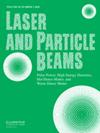Evolution of magnetic field in a weakly relativistic counterstreaming inhomogeneous e−/e+ plasmas
IF 1.9
4区 物理与天体物理
Q4 PHYSICS, APPLIED
引用次数: 1
Abstract
The nonlinear evolution of electron Weibel instability in a symmetric, counterstream, unmagnetized electron–positron e−/e+ plasmas is studied by a 2D particle-in-cell (PIC) method. The magnetic field is produced and amplified by the Weibel instability, which extracts energy from the plasma anisotropy. A weakly relativistic drift velocity of 0.5c is considered for two counterstreaming e−/e+ plasma flows. Simulations show that in a homogeneous e−/e+ plasma distribution, the magnetic field amplifies exponentially in the linear regime and rapidly decays after saturation. However, in the case of inhomogeneous e−/e+ plasma distribution, the magnetic field re-amplifies at post-saturation. We also find that the amount of magnetic field amplification at post-saturation depends on the strength of the density inhomogeneity of the upstream plasma distribution. The temperature calculation shows that the finite thermal anisotropy exists in the case of an inhomogeneous plasma distribution which leads to the second-stage magnetic field amplification after the first saturation. Such density inhomogeneities are present in a variety of astrophysical sources: for example, in supernova remnants and gamma-ray bursts. Therefore, the present analysis is very useful in understanding these astrophysical sources, where anisotropic density fluctuations are very common in the downstream region of the relativistic shocks and the widely distributed magnetic field.弱相对论逆流非均匀e - /e+等离子体中磁场的演化
用二维粒子池(PIC)方法研究了对称逆流非磁化电子-正电子e−/e+等离子体中电子维贝尔不稳定性的非线性演化。磁场是由从等离子体各向异性中提取能量的维贝尔不稳定性产生和放大的。考虑了两个逆流的e−/e+等离子体流0.5c的弱相对论漂移速度。模拟结果表明,在均匀的e−/e+等离子体分布下,磁场在线性状态下呈指数级放大,饱和后迅速衰减。然而,在e−/e+等离子体分布不均匀的情况下,磁场在饱和后再次放大。我们还发现,饱和后的磁场放大量取决于上游等离子体分布的密度不均匀性的强度。温度计算表明,在等离子体分布不均匀的情况下,存在有限的热各向异性,导致第一次饱和后的第二阶段磁场放大。这种密度不均匀性存在于各种天体物理来源中:例如,在超新星遗迹和伽马射线爆发中。因此,本文的分析对于理解这些天体物理源是非常有用的,在这些天体物理源中,各向异性密度波动在相对论性激波的下游区域和广泛分布的磁场中是非常常见的。
本文章由计算机程序翻译,如有差异,请以英文原文为准。
求助全文
约1分钟内获得全文
求助全文
来源期刊

Laser and Particle Beams
PHYSICS, APPLIED-
CiteScore
1.90
自引率
11.10%
发文量
25
审稿时长
1 months
期刊介绍:
Laser and Particle Beams is an international journal which deals with basic physics issues of intense laser and particle beams, and the interaction of these beams with matter. Research on pulse power technology associated with beam generation is also of strong interest. Subjects covered include the physics of high energy densities; non-LTE phenomena; hot dense matter and related atomic, plasma and hydrodynamic physics and astrophysics; intense sources of coherent radiation; high current particle accelerators; beam-wave interaction; and pulsed power technology.
 求助内容:
求助内容: 应助结果提醒方式:
应助结果提醒方式:


